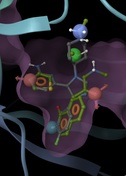Fahrvergnügen
Schrödinger makes science fun for structural biologists
Published June 17, 2011
Schrödinger, a little like a German car, has good looks and power under the hood. The 3D exterior is powered by Maestro, the primary molecular visualization interface in the Schrödinger Suite that integrates all of the other computational tools. It even supports 3D monitors and glasses that embed the user in a 3D viewing experience.
Overkill? Not so, says Woody Sherman, VP of application science at Schrödinger. Aha moments come when scientists view structures in these 3D renderings. “The most important moments come from combining graphics with calculations,” he says. “We gain intuition from looking at a structure, but the calculations shed light on the underlying physics. What's the balance between entropy and enthalpy? What hydrogen bonds are important? The calculations tell us how the physics is driving the properties of the system.”
In addition to Schrödinger's Maestro front end, which is licensed to academic users free of charge, there are many computational back-ends, including applications such as Jaguar (quantum mechanics), Glide (ligand docking), Desmond (molecular dynamics), PrimeX (crystal structure refinement) and nearly two dozen others. It is these tools that help scientists search a library of compounds to find a drug candidate or determine how a candidate molecule can be optimized to interact better with a target.
“We've invested heavily in Maestro's graphical modeling capabilities, but our primary software efforts are in the back-end,” says Sherman. “We want to help users to be the best modelers possible using Maestro so they can answer their scientific questions using the computational back-end.”
Depending on the goal, the backend may run on a desktop or it may need to be run on a cluster of hundreds of processors. For academics who are becoming entrepreneurs, the shift from using Schrödinger as a research tool to using it for drug discovery can be daunting, so Schrödinger created a partnership program to build entrepreneurial collaborations.
Collaboration with Schrödinger is also possible through the code itself. Most of Schrödinger's features are available via a Python API, and the Schrödinger development team has provided access through Maestro to many independent programs that have Python interfaces themselves. In addition, many of Schrodinger's computational algorithms come from contributing scientists who are members of the Schrodinger Scientific Advisory Board.
The May 2011 release of Schrödinger includes general-purpose graphics processing unit (GPGPU) support for the Core Hopping program. The GPGPU-enabled program combined with algorithmic enhancements allows for the processing of 1017 cores per hour. The new release also supports enhanced sampling methods for macrocycles, an improved physics-based energy model, and a structure-based approach to P450 site of metabolism prediction. For more information on the Schrödinger Suite, entrepreneurial partnerships, and code integration, please visit the Schrödinger website.
– Elizabeth Dougherty































